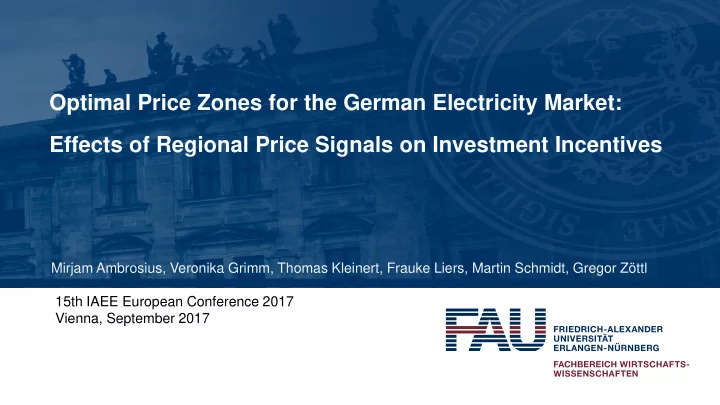

Optimal Price Zones for the German Electricity Market: Effects of Regional Price Signals on Investment Incentives Mirjam Ambrosius, Veronika Grimm, Thomas Kleinert, Frauke Liers, Martin Schmidt, Gregor Zöttl 15th IAEE European Conference 2017 Vienna, September 2017
Agenda 1. Motivation 2. Model Setup 3. Results 4. Next steps Price Zones for the German Electricity Market – September 2017 2
The introduction of price zones could be a possible solution for recent challenges in the German electricity market. Initial Situation Current Challenges in the German Electricity Market Missing / wrong investment incentives in liberalized electricity markets No signals for adequate electricity consumption Growing share of highly fluctuation renewables Possible Solution: Price Zones for the German Electricity Market Adequate Investment Incentives Locationally differentiated incentives for flexible consumption Price Zones for the German Electricity Market – September 2017 3
Before the introduction of price zones, several questions need to be answered. How many price zones do we need? What is the best partition for a given number? Which interzonal transmission capacities are optimal? How will investments in generation capacity change? What is the impact on prices? Price Zones for the German Electricity Market – September 2017 4
Agenda 1. Motivation 2. Model Setup 3. Results 4. Next steps Price Zones for the German Electricity Market – September 2017 5
Our model represents the sequence of decisions in the electricity market. Based on Grimm et al. (2016) Price Zones for the German Electricity Market – September 2017 6
The GATE* model translates the sequence of decisions into a three stage optimization model. Sequence of decisions of different actors in the market environment Consideration of physical transmission capacities via DC lossless approach Inclusion of neighboring countries via export functions Assumption: No market power to obtain unique equilibria (cf. Zöttl (2010)) *G eneration A nd T ransmission Price Zones for the German Electricity Market – September 2017 7 E xpansion, see Grimm et al. (2016)
Input data is mainly taken from NEP 2030. Network: Each federal state represented by a node Input Data ● Projection for 2035, with hourly spot market auctions (8760h). ● Hourly demand values for Germany and export/import to neighboring countries from Entso-E. ● Hourly RES feed-in, RES capacities taken from Network Expansion Plan (NEP) ● Production & investment cost of different conventional technologies taken from Konstantin (2013) Price Zones for the German Electricity Market – September 2017 8
Agenda 1. Motivation 2. Model Setup 3. Results 4. Next steps Price Zones for the German Electricity Market – September 2017 9
Preliminary results show that a north-south partition is optimal. Partition If two price zones are implemented, a north-south division is optimal. Prices Prices are higher in the south and lower in the north compared to status quo. Welfare Positive impact of price zones on welfare due to less redispatch and load-shedding Price Zones for the German Electricity Market – September 2017 10
Agenda 1. Motivation 2. Model Setup 3. Results 4. Next steps Price Zones for the German Electricity Market – September 2017 11
Next Steps Scenario reduction (k-means clustering) Test for more than 2 price zones Include investment in transmission line expansion Price Zones for the German Electricity Market – September 2017 12
Thank you for your attention! Mirjam Ambrosius University of Erlangen-Nürnberg Department of Economics mirjam.ambrosius@fau.de 13
Sources ● Grimm, V., A. Martin, M. Schmidt, M. Weibelzahl, G. Zöttl (2016). Transmission and Generation Investment in Electricity Markets: The Effects of Market Splitting and Network Fee Regimes. In: European Journal of Operational Research, vol. 254, no. 2, pp. 493 – 509. ● Zöttl, G. (2010). A Framework of Peak Load Pricing with Strategic Firms . In: Operations Research, vol. 58, no. 6, pp. 1637-1649. ● Konstantin, P. (2013). Praxisbuch Energiewirtschaft . Springer-Verlag. Berlin Heidelberg. Price Zones for the German Electricity Market – September 2017 14
Recommend
More recommend